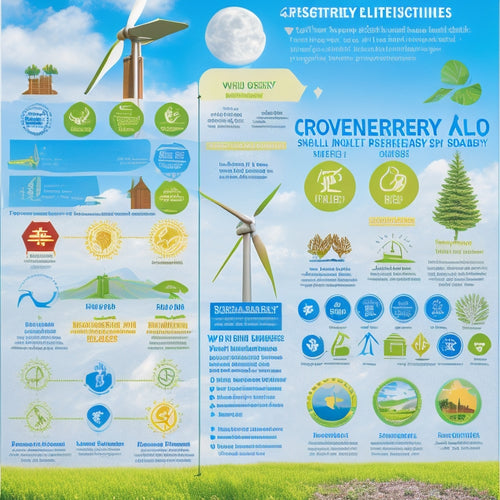
What to Know Before Investing in California Solar Panels
Share
As you consider investing in California solar panels, you'll want to understand the average costs, which range from $15,000 to $30,000, and investigate financing options to reduce upfront expenses. You'll also need to grasp net metering laws, which measure your system's energy production and excess energy credits. Choosing a qualified installer with certifications from NABCEP or CSI is essential. Additionally, researching solar panel efficiency ratings, California incentives, and energy storage options will help you make an informed decision. By examining these factors, you'll be well on your way to maximizing your return on investment - and there's more to uncover about how to get the most out of your California solar panels.
Key Takeaways
- Understand the average cost of California solar panels, ranging from $15,000 to $30,000, and financing options to reduce upfront costs.
- Choose a qualified installer with certifications, experience, and good customer reviews to ensure a successful installation and optimal energy production.
- Take advantage of California incentives, including a 26% federal tax credit, 10% state tax credit, and net metering program to reduce installation costs and maximize returns.
- Consider factors like roof size and condition, energy storage options, and maintenance requirements to ensure a suitable solar panel system for your home.
- Research and evaluate warranties and support services offered by installers to ensure long-term reliability and minimize potential issues.
California Solar Panel Costs
Your decision to invest in California solar panels hinges on one critical factor: cost. The average cost of solar panels in California ranges from $15,000 to $30,000, depending on the size of the system and the quality of the equipment.
However, with the right solar financing options, you can considerably reduce your upfront costs. Many solar installers offer financing plans with low or no down payments, allowing you to start generating electricity and saving money on your utility bills right away.
When it comes to installation timelines, California solar panels can be installed quickly and efficiently. Most installations take between 2-5 days, depending on the complexity of the project.
Once installed, your solar panel system will start generating electricity and reducing your reliance on the grid. With the right financing options and a smooth installation process, you can start enjoying the benefits of solar power in no time.
Understanding Net Metering Laws
When you install California solar panels, you'll need to understand how net metering laws work.
Fundamentally, a metering system measures the electricity your solar panels produce and feeds any excess back into the grid.
You'll earn credits for this excess energy, which you can then use to offset your energy consumption during periods of low solar production.
Metering System Basics
Most California homes with solar panels rely on a metering system to measure their energy production and consumption. This system is vital in understanding net metering laws, which allow you to generate your own electricity and export any excess to the grid. The metering technology used in California is advanced, providing accurate readings of your energy production and consumption.
You'll need to understand metering regulations to guarantee you're getting the most out of your solar panel investment. For instance, you'll need to have a net meter installed, which measures the difference between the electricity you produce and the electricity you consume.
The California Public Utilities Commission (CPUC) sets the rules for metering regulations, making sure that utilities provide accurate and transparent metering systems.
It's important to work with a reputable solar panel installer who understands the complexities of California's metering system and regulations. They can help you maneuver through the process, making sure you're getting the most out of your solar panel investment.
Excess Energy Credits
Net metering laws allow homeowners to generate their own electricity and export any excess to the grid, earning them excess energy credits. These credits can be used to offset your energy consumption during periods when your solar panels aren't producing enough power.
You can think of excess energy credits as a kind of "energy savings account". When you produce more energy than you consume, you build up credits that can be redeemed later. This is especially useful during winter months when your solar panels produce less energy due to shorter days and reduced sunlight.
Here is a breakdown of how excess energy credits work:
| Scenario | Credit Outcome |
|---|---|
| You produce 500 kWh and consume 300 kWh | You earn 200 kWh excess energy credits |
| You produce 300 kWh and consume 500 kWh | You use 200 kWh from your excess energy credits |
| You produce 500 kWh and consume 500 kWh | You earn 0 excess energy credits |
| You have 1000 kWh excess energy credits and consume 800 kWh | You have 200 kWh excess energy credits remaining |
| You have 0 excess energy credits and consume 200 kWh | You must purchase energy from the grid |
Through credit trading, you can take advantage of your excess energy credits to reduce your energy bills. By understanding how excess energy credits work, you can optimize your energy production and consumption, maximizing your savings.
Choosing the Right Installer
Several factors will influence the success of your California solar panel project, but none are more critical than choosing the right installer.
You'll want to hire a professional who can design and install a system that meets your energy needs and budget.
To guarantee you're making an informed decision, consider the following key factors:
- Installer Qualifications: Look for an installer with certifications from reputable organizations like the North American Board of Certified Energy Practitioners (NABCEP) or the California Solar Initiative (CSI).
These certifications confirm the installer has the necessary knowledge and skills to design and install a safe and efficient solar panel system.
- Customer Reviews: Check online review platforms like Yelp, Google, or Angie's List to see what previous customers have to say about their experience with the installer.
Pay attention to ratings, comments, and complaints to get a sense of the installer's reputation and level of customer service.
- Experience with Similar Projects: Ask the installer about their experience with projects similar to yours regarding size, complexity, and scope.
This will give you an idea of their ability to handle your specific project requirements.
Solar Panel Efficiency Ratings
When researching California solar panels, you'll come across two key metrics: panel conversion efficiency and energy output ratings.
These ratings indicate how well a solar panel converts sunlight into electricity, with higher ratings indicating more efficient energy production.
Panel Conversion Efficiency
About 20% of the sun's energy that hits a solar panel is lost due to heat, reflection, and other inefficiencies. This means that only a fraction of the sun's energy is actually converted into usable electricity.
When investing in California solar panels, it's crucial to comprehend panel conversion efficiency.
You'll want to look for solar panels with high efficiency ratings, as they can generate more power per hour of sunlight. Here are three key factors to take into account:
-
Panel technology advancements: Advances in panel technology have led to more efficient energy conversion. Look for panels with the latest technology, such as bifacial or PERC (Passivated Emitter and Rear Cell) panels, which can achieve higher efficiency ratings.
-
Solar efficiency comparison: Compare the efficiency ratings of different panels to verify you're getting the best option. A higher efficiency rating means more power per unit area, which can be beneficial for smaller rooftops or limited space.
-
Efficiency in real-world conditions: Keep in mind that efficiency ratings are typically measured under ideal laboratory conditions. Look for panels that perform well in real-world conditions, such as high temperatures and low light levels.
Energy Output Ratings
Frequently, homeowners and businesses in California investing in solar panels overlook the importance of energy output ratings, also known as solar panel efficiency ratings. These ratings are essential in determining how much electricity your solar panel system will produce. A higher energy output rating means your system will generate more power, saving you more on your electricity bills.
When comparing solar panels, you'll notice that each model has an energy output rating, usually expressed in watts (W). This rating indicates the maximum power the panel can produce under ideal conditions. For instance, a 300W solar panel will produce more electricity than a 250W panel.
To make an accurate efficiency comparison, consider the panel's energy output per unit area. This is typically measured in watts per square foot (W/ft²).
As you evaluate different solar panels, prioritize those with higher energy output ratings to maximize your return on investment. Keep in mind that other factors, such as panel durability and warranty, also impact the overall performance of your solar panel system.
California Incentives and Rebates
Many Californians are taking advantage of the state's generous incentives and rebates to offset the upfront cost of installing solar panels.
As you consider investing in California solar panels, you'll want to take advantage of these benefits to maximize your return on investment.
Here are some key incentives to keep in mind:
-
Federal Incentives: The federal government offers a tax credit of 26% of the total cost of your solar panel system, which can greatly reduce your tax liability.
-
State Tax Benefits: California offers a state tax credit of 10% of the total cost of your solar panel system, which can further reduce your tax burden.
-
Net Metering: California's net metering program allows you to sell any excess energy your solar panels produce back to the grid, offsetting your energy costs and providing additional savings.
Roof Size and Condition
You've invested time in researching California incentives and rebates, and now it's essential to evaluate another significant factor: your roof size and condition.
A solar panel system's performance is heavily influenced by the size and condition of your roof. A larger roof provides more space for solar panels, which can increase energy production. However, a larger roof also means more potential for obstructions, such as vents, skylights, or chimneys, that can reduce energy production.
When evaluating your roof's condition, consider its age, material, and structural integrity. A damaged or old roof may need to be replaced before installing solar panels.
Additionally, the roof's orientation is important, as south-facing roofs receive the most sunlight. A shading analysis will help identify any obstructions, such as trees or neighboring buildings, that can impact energy production.
Energy Storage Options Available
You're likely considering energy storage options to maximize the benefits of your California solar panels.
Battery backup systems, which store excess energy generated during the day for later use, are a popular choice.
You may also want to investigate solar plus storage, which combines your solar panel system with energy storage, and energy independence options that enable you to disconnect from the grid altogether.
Battery Backup Systems
Frequently, homeowners who invest in California solar panels also consider pairing their system with a battery backup system, an essential energy storage option that guarantees a steady power supply during outages or emergencies.
When evaluating battery backup systems, you should consider the following key factors:
-
Battery Lifespan: The lifespan of your battery will impact its overall value and performance. Look for batteries with a long lifespan to maximize your investment.
-
Installation Requirements: Verify that your battery backup system meets the necessary installation requirements, including proper ventilation, temperature control, and electrical connections.
-
Energy Management: A sophisticated energy management system will optimize your energy usage, providing cost savings and facilitating a seamless shift between grid power and battery backup.
Solar Plus Storage
Many California homeowners opting for solar panels are uncovering the advantages of combining them with energy storage options, a concept known as Solar Plus Storage. This integrated system allows you to store excess energy generated by your solar panels during the day for use at night or during power outages.
Solar technology advancements have made energy storage solutions more efficient and cost-effective. You can choose from various energy storage solutions, including lithium-ion batteries, lead-acid batteries, and flow batteries. Each type has its pros and cons, and the right choice depends on your energy needs, budget, and preferences.
For instance, lithium-ion batteries are popular for their high energy density and long lifespan, while lead-acid batteries are more affordable but heavier and less efficient.
When selecting an energy storage solution, consider factors such as depth of discharge, round-trip efficiency, and warranty. It's crucial to consult with a solar expert to determine the best Solar Plus Storage configuration for your specific situation.
Energy Independence Options
By opting for Solar Plus Storage, California homeowners can choose from a range of energy independence options, each designed to maximize their energy autonomy.
You'll have the power to control your energy usage, reducing your reliance on the grid and saving money on your utility bills.
When it comes to energy independence, you have three primary options to evaluate:
-
Grid-Tied Systems: These systems allow you to generate your own renewable energy and feed any excess back into the grid. You'll still have access to grid power when you need it, but you'll also be generating your own clean energy.
-
Grid-Interactive Systems: These systems take grid-tied systems to the next level, providing backup power during grid outages. You'll have a reliable source of energy, even when the grid is down.
-
Off-Grid Systems: For ultimate energy independence, off-grid systems allow you to disconnect from the grid entirely. You'll be self-sufficient, relying solely on your renewable energy sources to power your home.
With Solar Plus Storage, you can choose the level of energy independence that's right for you, utilizing the power of renewable energy to take control of your energy future.
System Maintenance Requirements
You'll want to guarantee your California solar panels operate at peak performance, and that requires regular system maintenance. This includes establishing cleaning schedules to remove dirt, debris, and other obstructions that can reduce energy output.
A typical cleaning schedule involves inspecting and cleaning your solar panels every 6-12 months, depending on your location and environmental conditions.
Additionally, you'll need to perform performance monitoring to identify any issues or inefficiencies in your system. This can be done through remote monitoring systems that track your energy production and alert you to any anomalies.
Regular maintenance also involves inspecting electrical connections, inverters, and other system components to verify they're functioning properly.
Local Building Codes Compliance
As you maintain your California solar panels to guarantee peak performance, it's equally important to confirm compliance with local building codes.
Failure to do so can result in costly penalties, fines, or even the removal of your solar panel system.
Before installing your solar panels, you should:
-
Verify zoning regulations: Make certain that your solar panel system complies with local zoning laws, including setback requirements, height restrictions, and other regulations that may impact your system's placement and design.
-
Obtain necessary permits: Secure all necessary permits and approvals from your local government before commencing installation. This includes electrical permits, building permits, and other permits required by your local authorities.
-
Comply with electrical and fire codes: Ascertain that your solar panel system meets all relevant electrical and fire codes, including those related to wiring, grounding, and fire safety.
Warranties and Support Services
With your California solar panels installed and compliant with local building codes, it's essential to evaluate the warranties and support services that come with your system. You should understand the different warranty types offered by your solar panel provider. Typically, there are two types of warranties: product warranties and performance warranties.
Product warranties cover defects in the solar panels, inverters, and other equipment, while performance warranties guarantee a certain level of energy production.
When reviewing warranty options, consider the warranty period, coverage, and maintenance requirements. You'll also want to evaluate the support services offered, such as monitoring, maintenance, and repair services.
Look for providers that offer 24/7 monitoring, prompt response times, and thorough maintenance plans. Additionally, confirm that the provider has a dedicated customer support team to address any concerns or issues you may have.
Frequently Asked Questions
Can I Install Solar Panels on a Rented Property in California?
You can investigate installation options for solar panels on a rented property in California, but you'll need to review your rental agreements to guarantee permission from your landlord and understand any potential restrictions or requirements.
How Do Solar Panels Affect Property Taxes in California?
As you capture California's golden sun, you'll want to know that installing solar panels won't increase your property taxes, thanks to property tax exemptions. Plus, you'll reap the benefits of solar energy credits, brightening your financial future.
Are There Any California State Regulations on Solar Panel Aesthetics?
You'll find California state regulations on solar panel aesthetics focus on ensuring solar panel design aligns with local designer styles, adhering to aesthetic guidelines that balance energy efficiency with visual appeal, allowing you to capture power without compromising your property's look.
Can I Sell My California Home With Leased Solar Panels?
When you're ready to 'cut and run', you'll be glad to know you can sell your California home with leased solar panels, but be aware that the leased solar benefits may impact the home sale process, requiring buyer assumption or panel removal.
Do California Solar Panels Work During Power Outages?
You'll find that California solar panels don't provide power during outages, unless you've invested in backup battery systems, which can store excess energy for later use, maximizing solar panel efficiency when the grid goes down.
Conclusion
As you commence on your California solar panel expedition, remember that knowledge is power. You've got the facts, from costs to warranties, and now it's time to utilize the sun's energy. Will you seize the opportunity to reduce your carbon footprint and save on your electricity bill? The golden state is shining bright with possibilities - so go ahead, take the first step, and let the sunshine in!
Related Posts
-

Solar Energy Benefits for Sustainable Living
Solar energy provides numerous benefits for sustainable living that you can't overlook. By switching to solar, you'll...
-

Renewable Energy Certifications for Businesses
Renewable energy certifications are essential for your business, showcasing your commitment to sustainability and enh...
-

High-Performance Solar Solutions for Sustainable Living
High-performance solar solutions are your gateway to sustainable living, maximizing energy efficiency while considera...


